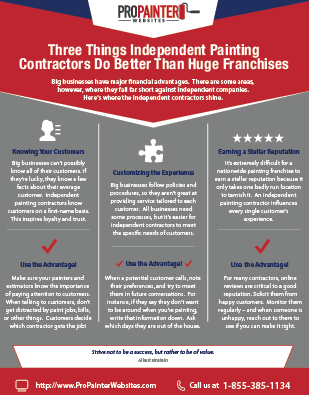Factors To Consider For Industrial Outside Painting By Period: Crucial Info You Ought To Have
Factors To Consider For Industrial Outside Painting By Period: Crucial Info You Ought To Have
Blog Article
Post Written By-Regan Urquhart
When you're intending an industrial outside paint job, seasonal aspects can make or break your outcomes. You'll want to consider how temperature and moisture effect paint application and drying out times. Selecting the ideal period can ensure your paint adheres effectively and lasts much longer. Yet which seasons are genuinely the most effective for this type of work? Let's check out the crucial elements that can influence your project's success.
The Effect of Temperature on Paint Application
When you're preparing an industrial exterior painting job, the temperature level can considerably affect how well the paint sticks and dries out.
Preferably, you wish to paint when temperatures vary between 50 ° F and 85 ° F. If it's also cool, the paint might not cure properly, causing problems like peeling off or fracturing.
On the other side, if it's as well warm, the paint can dry out too quickly, preventing proper attachment and leading to an irregular surface.
You need to likewise take into consideration the time of day; early morning or late afternoon provides cooler temperature levels, which can be more desirable.
Constantly inspect the maker's suggestions for the particular paint you're utilizing, as they often offer assistance on the perfect temperature level array for ideal results.
Humidity and Its Effect on Drying Times
Temperature level isn't the only ecological aspect that affects your commercial outside painting job; humidity plays a significant duty as well. High moisture degrees can decrease drying times dramatically, impacting the total top quality of your paint task.
When the air is filled with wetness, the paint takes longer to cure, which can bring about problems like poor attachment and a greater threat of mold development. If you're painting on a specifically damp day, be prepared for extensive delay times between layers.
https://paxtoneqblv.goabroadblog.com/34208961/learn-exactly-how-to-plainly-convey-your-vision-to-your-painting-professional-to-ensure-an-effective-task-result to check regional weather conditions and plan accordingly. Preferably, go for moisture degrees in between 40% and 70% for optimal drying out.
Keeping https://www.architecturaldigest.com/story/wall-decor-ideas in mind ensures your task remains on track and supplies a long-term surface.
Best Seasons for Commercial Outside Painting Projects
What's the best time of year for your business external paint jobs?
Springtime and very early autumn are typically your best options. Throughout these periods, temperatures are mild, and humidity levels are often lower, producing suitable conditions for paint application and drying out.
Avoid summer's intense heat, which can trigger paint to completely dry too rapidly, resulting in bad adhesion and finish. Similarly, winter months's cold temperature levels can impede correct drying and healing, taking the chance of the durability of your paint task.
Go for days with temperatures in between 50 ° F and 85 ° F for optimal outcomes. Keep in mind to inspect the regional weather report for rainfall, as damp problems can wreck your project.
Preparation around these aspects ensures your paint task runs smoothly and lasts longer.
Conclusion
Finally, intending your business external painting projects around seasonal considerations can make a considerable difference in the outcome. By organizing job throughout the excellent temperature levels and humidity levels, you'll guarantee far better bond and drying out times. Bear in mind to watch on neighborhood weather report and choose the right time of year-- spring and very early fall are your best options. Taking these steps will assist you achieve a long lasting and expert finish that lasts.
